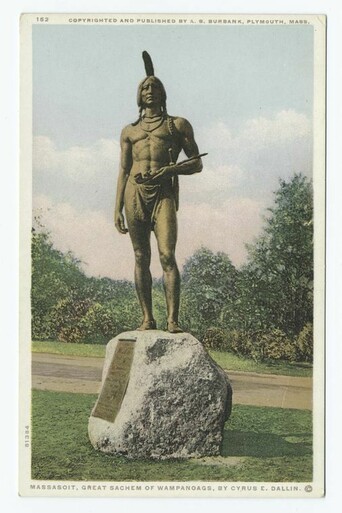National Day of Mourning Monument (1998)
- Date
- 1970
- Material
- Bronze, Memorial Plaque
- Author/Maker
- Erected by the Town of Plymouth on behalf of the United American Indians of New England
Description
Thanksgiving does not mean the same thing to all Americans. For many Indigenous People, it is a day to reflect on the arrival of Europeans and the beginning of a time of monumental change in their way of life. Reflecting on the centrality of Thanksgiving to American life, in the mid-20th century, groups began to use the holiday to comment on the American experiment. In 1970, a new Thanksgiving Day tradition, called Day of Mourning, began in Plymouth. A Wampanoag man named Wamsutta (Frank) James organized a demonstration to bring awareness to the concerns of the Indigenous community including the way Native people had been written about in history. The Day of Mourning has been held every year since and, in 1998, the town of Plymouth erected a plaque atop Cole’s Hill commemorating the historical significance of the event. 1
To this day, however, Native People across the continent also maintain their own traditions of giving thanks throughout the year. The evolution of Thanksgiving is not over. Rather, it continues each year when diverse people gather to break bread, learn from one another, and, in turn, shape the future of this American holiday.
Transcription
NATIONAL DAY OF MOURNING
Since 1970, Native Americans have gathered at noon on Cole's Hill in Plymouth to commemorate a National Day or Mourning on the U.S. Thanksgiving holiday. Many Native Americans do not celebrate the arrival of the Pilgrims and other European settlers. To them, Thanksgiving Day is a reminder of the genocide of millions of their people, the theft of their lands, and the relentless assault on their cultures. Participants in National Day of Mourning honor Native ancestors and the struggles of Native peoples to survive today. It is a day of remembrance and spiritual connection as well as a protest of the racism and oppression which Native Americans continue to experience.
Erected by the Town of Plymouth on behalf of the United American Indians of New England
Media

Massasoit, Great Sachem of Wampanoags, by Dallin, Plymouth, Mass." c. 1898-1931 (Detroit). The New York Public Library Digital Collections, The Miriam and Ira D. Wallach Division of Art, Prints and Photographs: Photography Collection
Discussion Questions
-
Why is the National Day of Mourning significant?
-
How does the National Day of Mourning tell a different story about Thanksgiving?
-
Does the National Day of Mourning change the way you think about Thanksgiving? If so, how?